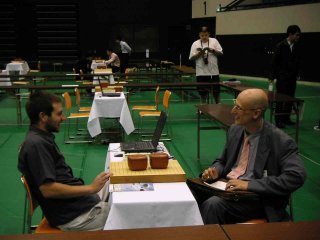 "No, I never play go on the Internet, I don't like it. I mean, staring
at this small screen the whole time, it is different; I can't get exited
about it. What's the fun of playing against a machine? I very much
prefer a real opponent of flesh and blood to play against instead of a
metal box any day of the week."
"No, I never play go on the Internet, I don't like it. I mean, staring
at this small screen the whole time, it is different; I can't get exited
about it. What's the fun of playing against a machine? I very much
prefer a real opponent of flesh and blood to play against instead of a
metal box any day of the week."
The words of Ben Gale, a 23-year old playing under the flag of South
Africa.
It is Ben's 1st time at the WAGC. Watching him from a distance, one
could tell he visibly enjoyed both the 1st and 2nd round game immensely.
In the first round he was matched against one of the favorites, the
representative from Japan, Kikuchi.
"What I like about go? Hmm, well it is not winning because when I played
Kikuchi I was properly taken in but I had the time of my life! I also
think that Kikuchi was being nice to me on purpose. I mean, he could've
easily killed a big group of mine but he didn't do. Well, actually he
didn't need the group, but all the same, he played very kindly I feel."
Ben who has just started an electronics trading company learned to play
go at age 14 from his father. "My father was about 3 kyu I think. It
took me about two years to get ahead of him. I was rewarded this year's
seat to the WAGC owing to the point system. I'm not the strongest player
in my country but most of the strong players in South Africa are not
that active anymore. I can't hold a candle to Victor. (Victor Guan Chow,
5th at the 24th WAGC) He loves all kind of games but I think that he is
best at go."
Ben plays about once week on Tuesdays at a coffee shop. They have
some 30 registered players there but the number of people showing up
regularly is more between 10~20. Before picking up go he was a chess
player of some skill.
"Well, it was like Chess, Chess, Chess and than suddenly Go. I felt
much more attracted to Go than I ever felt to Chess. But to answer your
question ``what I like about go''. Well, for one thing, it is the mental
battle you are having with the other guy. Also, the feeling you get the
moment you know you did something right. This is very important to me
and very enjoyable in that, every now and then you know you played a
good move. That is why I say; I don't mind losing a bit, as long as I
lose well."
With this attitude Ben will undoubtedly keep improving until he perhaps
some day can meet Victor on even terms. In spite of his obvious talent
Ben is also quite modest as his last words of the interview prove: "I'd
be satisfied if I can get three wins in this field. If I could win 4
games I'll be very happy."
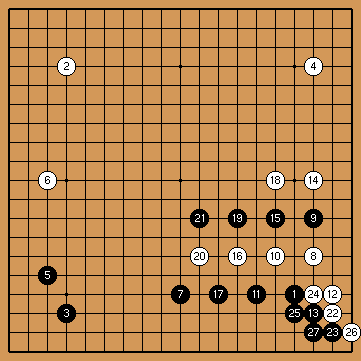
| Event |
26th WAGC, round 2 |
|---|
| Date |
2005 May 24 |
|---|
| Place |
Nagoya, Japan |
|---|
| Black |
Ben Gale, South Africa |
|---|
| White |
Hector Paiz, Guatamala |
|---|
| Commentary |
Pieter Mioch, 6d |
|---|
| Game record |
|
|---|
Figure 1: 1-27

Diagram 1
In diagram 1 the most common continuation is shown. Instead of white's
game move at 6 (figure 1), splitting the bottom black position in two
with white 1 is the way to go. Next, black might first want to play at
either A or B, but it is often an interesting approach to not play it
just yet and have a look elsewhere first. Black 2 or thereabouts is
the biggest point on the board.
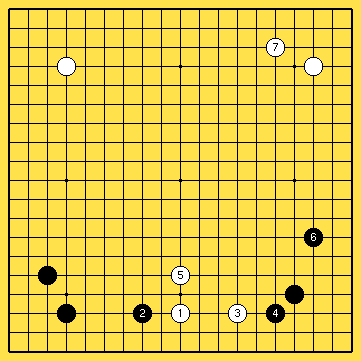
Diagram 2
Diagram 2 gives a peaceful example of what happens if black chooses to
play at 2, undoubtedly a huge move. White 3 is not the only move, of
course, but it keeps things simple and especially now that the komi has
become 6.5, there is often no point in white complicating the game as
long as he feels he is not behind. After black 6, white gets to make a
shimari in the upper right corner. This might be one reason for black
not playing A or B in diagram 1. Diagram 2 ends with white getting the
excellent shimari making move with stone 7.
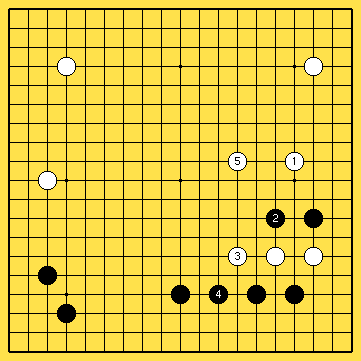
Diagram 3
Returning to the actual game grid (figure 1), white is usually
reluctant to exchange white 12, black 13. After this it is not possible
anymore for white to make an invasion in the corner and since there is
a black stone at 9, an extension towards to right also is no longer
possible.
Diagram 3 shows an alternative which makes the game a bit easier for
white. This is not a joseki but this is most probably the way white
wants to play judging from what happens in the game. The pincer of white
1 is a little bit far but this distance enables white to play at 5. If
this two-space jump were any closer to the black stones then black would
have something to aim at? cutting!.
Now black has a much more difficult time to settling his right side
stones (although they're not gonna die, of course?). What is also nice
for white is that an invasion at A still is an option which might become
very attractive later on. If black wants to prevent white from entering,
then he'll have to add a move at B or thereabouts. This in turn will
mean that white gets an extra move in the center. This, in turn, might
make the game rather difficult for black. Although black would very much
like to play B, he probably has to wait a bit in order to find the right
moment.
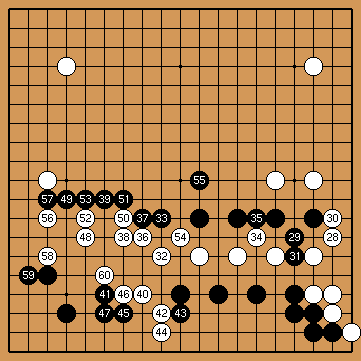
Figure 2: 28-60
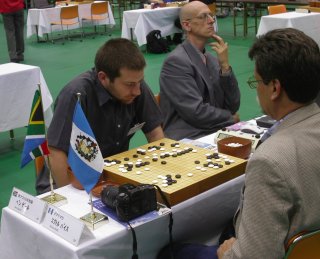
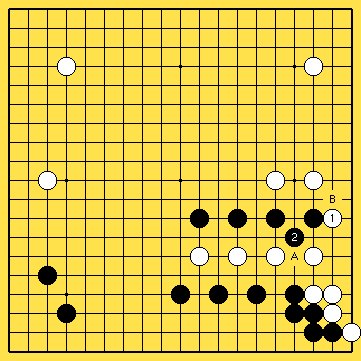
Diagram 4
White's 28th play in the match (Figure 2) is a little bit funny
looking, as the standard tesuji would be to connect by attaching at 1 as
shown in diagram 4. The problem with this, often nicely working move, is
that black 2 either cuts the white stones in two or prevents him from
connecting underneath (if white answers at A black will play B).
White, however is in need of eyes and he doesn't really want to move
towards the strong black lower left corner.
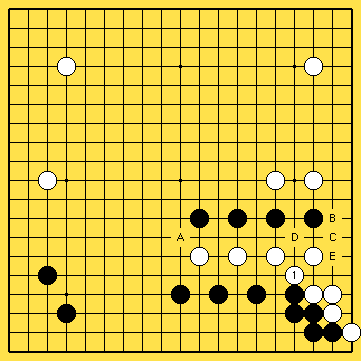
Diagram 5
So, white 1 in diagram 5 seems to be the simplest way of playing and
again, simplicity is not something you are averse to, especially if
you're holding the white stones. (There is a 6.5 point reward waiting
for you; you only have to finish the game in order to get it!!!)
White 1 aims at both moving out at A and connecting underneath at B. If
black prevents the connecting by playing at C, for example, white can
move out towards the center. However, he also can make eyes by peeping
at D before blocking at E. White is not unhappy with "only" making eyes.
He has been playing in a black influence sphere, a place were he not
could hope to make many points to begin with.
Game move black 31 makes the game difficult for white. Since he is cut
in two, his choices are limited. After 32, however, the representative
from South Africa felt that he should have defended the territory at the
bottom. In my opinion, this is a little bit too much "Mr. Nice Guy".
Diagram 6 looks very attractive the longer you look at it. It is
obvious that white will have a very hard time making the eyes he is so
desperately in need of.
Diagram 6, by the way, seems to prove that white 32 was not a realistic
move.

Diagram 6
Diagram 1 shows the game to move 61. In the end black won by 9.5 points
but for the best half it was a 3-4 point game. It took, however, almost
4 hours to finish and both participants must have been tired for sure.
Hector Paiz from Guatemala, holding the white stones, was registered as
a 3 kyu player. He played a very strong game and next time deserves to
enter as at least shodan.
| 

 "No, I never play go on the Internet, I don't like it. I mean, staring
at this small screen the whole time, it is different; I can't get exited
about it. What's the fun of playing against a machine? I very much
prefer a real opponent of flesh and blood to play against instead of a
metal box any day of the week."
"No, I never play go on the Internet, I don't like it. I mean, staring
at this small screen the whole time, it is different; I can't get exited
about it. What's the fun of playing against a machine? I very much
prefer a real opponent of flesh and blood to play against instead of a
metal box any day of the week."








